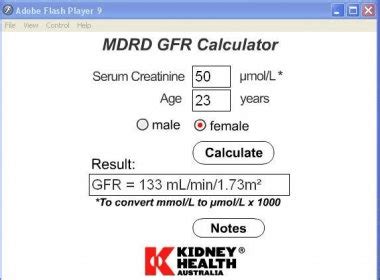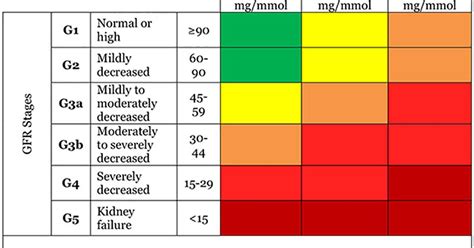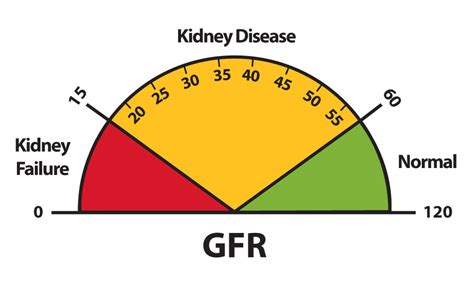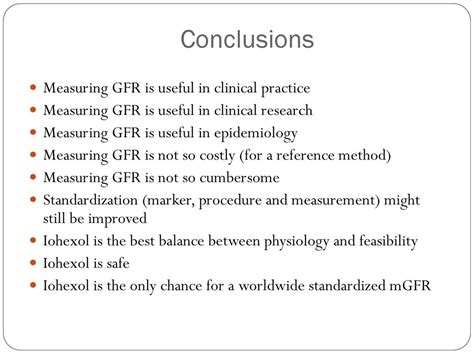Intro
Discover the GFR medical abbreviation meaning, exploring Glomerular Filtration Rate, kidney function, and renal health, with related terms like eGFR, CKD, and nephrology.
The medical field is filled with abbreviations and acronyms that can be confusing for those not familiar with them. One such abbreviation is GFR, which stands for Glomerular Filtration Rate. Understanding the meaning and significance of GFR is crucial for healthcare professionals and patients alike, as it plays a vital role in assessing kidney function.
GFR is a measure of the rate at which the kidneys filter waste and excess fluids from the blood. It is an essential indicator of kidney health and is used to diagnose and monitor kidney disease. The glomeruli, tiny blood vessels within the kidneys, filter the blood to remove waste products and excess substances, which are then excreted in the urine. The GFR test measures the volume of fluid filtered from the renal glomerular capillaries into the Bowman's capsule per unit time.
The importance of GFR cannot be overstated, as it helps healthcare providers to identify potential kidney problems early on. Kidney disease can lead to serious complications, such as heart disease, stroke, and even death. By monitoring GFR, healthcare providers can take proactive steps to prevent or slow the progression of kidney disease. In addition, GFR is used to monitor the effectiveness of treatments for kidney disease and to adjust medication dosages accordingly.
What is GFR Measurement?

GFR measurement is typically done using a blood test that measures the level of creatinine in the blood. Creatinine is a waste product that is produced by the muscles and filtered by the kidneys. By measuring the level of creatinine in the blood, healthcare providers can estimate the GFR. The GFR test can also be done using a 24-hour urine collection, which measures the amount of creatinine cleared from the body over a 24-hour period.
The normal GFR value varies depending on age, sex, and body size. In general, a GFR of 90 mL/min/1.73 m² or higher is considered normal. A GFR below 60 mL/min/1.73 m² indicates kidney disease, and the lower the GFR, the more severe the disease. For example, a GFR of 30-59 mL/min/1.73 m² indicates moderate kidney disease, while a GFR below 15 mL/min/1.73 m² indicates severe kidney disease.
How is GFR Calculated?

GFR is calculated using a formula that takes into account the patient's age, sex, body size, and creatinine level. The most commonly used formula is the Modification of Diet in Renal Disease (MDRD) formula, which is as follows:
GFR (mL/min/1.73 m²) = 175 x (serum creatinine)^-1.154 x (age)^-0.203 x (0.742 if female) x (1.212 if African American)
The MDRD formula is widely used because it is simple and easy to calculate. However, it has some limitations, such as not being accurate for patients with severe obesity or those who have undergone kidney transplantation.
Factors that Affect GFR
Several factors can affect GFR, including:
- Age: GFR decreases with age, with the average GFR decreasing by 1 mL/min/1.73 m² per year after the age of 40.
- Sex: Women tend to have lower GFR values than men, due to their smaller body size.
- Body size: GFR is higher in people with larger body size, due to the increased muscle mass.
- Kidney disease: Kidney disease can significantly reduce GFR, depending on the severity of the disease.
- Medications: Certain medications, such as nonsteroidal anti-inflammatory drugs (NSAIDs), can affect GFR.
GFR Stages

GFR is categorized into five stages, based on the level of kidney function. The stages are as follows:
- Stage 1: GFR ≥ 90 mL/min/1.73 m² (normal kidney function)
- Stage 2: GFR = 60-89 mL/min/1.73 m² (mild kidney disease)
- Stage 3: GFR = 30-59 mL/min/1.73 m² (moderate kidney disease)
- Stage 4: GFR = 15-29 mL/min/1.73 m² (severe kidney disease)
- Stage 5: GFR < 15 mL/min/1.73 m² (kidney failure)
Each stage of GFR has different treatment options and management strategies. For example, patients with stage 1 GFR may not require any treatment, while those with stage 5 GFR may require dialysis or kidney transplantation.
GFR and Kidney Disease

GFR is a critical indicator of kidney health, and a low GFR can indicate kidney disease. Kidney disease can be caused by a variety of factors, including diabetes, high blood pressure, and family history. If left untreated, kidney disease can lead to serious complications, such as heart disease, stroke, and even death.
The relationship between GFR and kidney disease is complex, and a low GFR can indicate different types of kidney disease. For example, a GFR of 30-59 mL/min/1.73 m² may indicate chronic kidney disease (CKD), while a GFR below 15 mL/min/1.73 m² may indicate end-stage renal disease (ESRD).
Treatment Options for Low GFR
Treatment options for low GFR depend on the underlying cause of the kidney disease and the severity of the disease. Some common treatment options include:
- Medications: Medications such as angiotensin-converting enzyme (ACE) inhibitors and angiotensin receptor blockers (ARBs) can help to slow the progression of kidney disease.
- Lifestyle modifications: Lifestyle modifications such as a healthy diet, regular exercise, and stress reduction can help to manage kidney disease.
- Dialysis: Dialysis is a treatment option for patients with end-stage renal disease (ESRD).
- Kidney transplantation: Kidney transplantation is a treatment option for patients with ESRD.
GFR and Other Health Conditions

GFR is not only important for assessing kidney health, but it is also related to other health conditions. For example, a low GFR has been linked to an increased risk of heart disease, stroke, and mortality. Additionally, GFR is used to monitor the effectiveness of treatments for other health conditions, such as diabetes and high blood pressure.
The relationship between GFR and other health conditions is complex, and a low GFR can indicate different types of health problems. For example, a GFR of 30-59 mL/min/1.73 m² may indicate an increased risk of cardiovascular disease, while a GFR below 15 mL/min/1.73 m² may indicate an increased risk of mortality.
Monitoring GFR
Monitoring GFR is essential for patients with kidney disease, as it helps to track the progression of the disease and adjust treatment options accordingly. GFR can be monitored using a variety of methods, including:
- Blood tests: Blood tests can measure the level of creatinine in the blood, which is used to estimate GFR.
- Urine tests: Urine tests can measure the amount of creatinine cleared from the body over a 24-hour period.
- Imaging tests: Imaging tests such as ultrasound and CT scans can help to assess kidney damage and monitor the progression of kidney disease.
Conclusion and Final Thoughts

In conclusion, GFR is a critical indicator of kidney health, and a low GFR can indicate kidney disease. Understanding the meaning and significance of GFR is essential for healthcare professionals and patients alike, as it helps to diagnose and monitor kidney disease. By monitoring GFR, healthcare providers can take proactive steps to prevent or slow the progression of kidney disease and adjust treatment options accordingly.
We invite you to share your thoughts and questions about GFR and kidney health in the comments section below. If you have any personal experiences or concerns about kidney disease, please feel free to share them with us. Additionally, if you have any questions or topics you would like us to cover in future articles, please let us know.
What does GFR stand for?
+GFR stands for Glomerular Filtration Rate, which is a measure of the rate at which the kidneys filter waste and excess fluids from the blood.
What is the normal GFR value?
+The normal GFR value varies depending on age, sex, and body size, but is generally considered to be 90 mL/min/1.73 m² or higher.
What are the stages of GFR?
+The stages of GFR are: Stage 1 (GFR ≥ 90 mL/min/1.73 m²), Stage 2 (GFR = 60-89 mL/min/1.73 m²), Stage 3 (GFR = 30-59 mL/min/1.73 m²), Stage 4 (GFR = 15-29 mL/min/1.73 m²), and Stage 5 (GFR < 15 mL/min/1.73 m²).
How is GFR calculated?
+GFR is calculated using a formula that takes into account the patient's age, sex, body size, and creatinine level.
What are the treatment options for low GFR?
+Treatment options for low GFR depend on the underlying cause of the kidney disease and the severity of the disease, and may include medications, lifestyle modifications, dialysis, and kidney transplantation.
